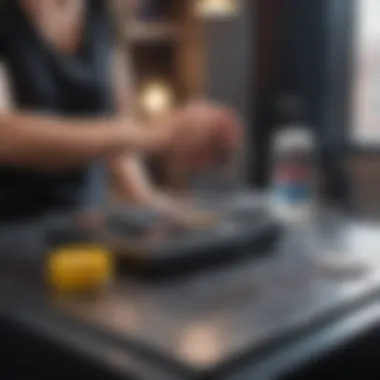Effective DIY Methods to Remove Dip Powder Nails


Intro
The rise of dipped nails offers a vibrant and durable alternative to traditional nail polish. However, when it comes time for dip powder removal, many individuals wonder about the best methods to undertake this task at home. Understanding the processes involved not only empowers users but also saves money on salon visits.
In this guide, we aim to dissect the various techniques and tools available for effective dip powder nail removal. We will also address safety concerns and necessary precautions, ensuring that you can approach this task with confidence. Along the way, you will gain useful insights into how to achieve a satisfactory result while maintaining the health of your natural nails.
Understanding Dip Powder Nails
Dip powder nails have gained popularity as a long-lasting and durable nail enhancement. This section explores what dip powder nails are, their benefits, and some considerations or drawbacks when using them. Understanding these elements will help in determining the best approach for removal and care after the dip is taken off.
What are Dip Powder Nails?
Dip powder nails are a type of manicure where colored powder is applied to the nails after they are coated in a bonding solution. The process involves dipping the nails into the powder, and then each layer is sealed with a top coat. This creates a strong bond that can stay intact for weeks. Unlike traditional nail polish, dip powder nails do not require UV light to cure, making them an attractive option for many.
Benefits of Dip Powder Nails
There are several benefits associated with dip powder nails:
- Durability: Dip powder nails are known for their strength and longevity, often lasting three to four weeks without chipping.
- Quick Application: The process is typically faster than other nail enhancement methods, allowing for efficient service.
- Variety of Colors: Users can choose from a wide range of colors and finishes, adding to their aesthetic appeal.
- Less Odorous: Compared to acrylics and gel nails, dip powders generally produce less odor during application.
- Minimal Dry Time: Since there is no need for UV light, users can avoid waiting for their nails to dry.
These benefits make dip powder nails a popular choice amongst individuals looking for a durable and visually appealing option.
Drawbacks of Dip Powder Nails
While there are many advantages, potential drawbacks also exist:
- Nail Health: Frequent use of dip powder nails can weaken natural nails, leading to issues like brittleness.
- Removal Challenges: The removal process can be tedious and may damage the nail if not done correctly.
- Allergic Reactions: Some individuals may experience allergic reactions to the chemicals involved in the dip application.
- Cost: Regular visits to a salon for maintenance can add up, making it more expensive in the long term compared to a traditional manicure.
It is important to weigh these considerations against the benefits, to make a well-informed decision about using dip powder nails and how to effectively manage their removal.
Preparing for Dip Removal
Preparing for dip removal is a crucial phase in the process. Ensuring you have the right tools and understanding your nail's condition can make the removal process more effective and safe. Improper preparation may lead to damage or prolonged removal times, making it essential to focus on this initial step. Proper tools and a clear assessment of nail health can enhance the outcome, leading to healthier nails post-removal.
Gathering Necessary Tools
To remove dip powder effectively, gathering the necessary tools is vital. Each tool has a specific role in the removal process. Using the right equipment can make a significant difference in how quickly and safely you remove the dip powder.
Acetone
Acetone is the primary solvent used in removing dip powder nails. This powerful nail polish remover penetrates the dip powder, breaking it down for easier removal. The key characteristic of acetone is its fast evaporation rate. This makes it a popular choice for at-home nail care. However, acetone can be very drying to nails and skin, making moisturization important after use.
Nail file
A nail file plays an essential role in the dip removal process. It allows for the careful filing down of the top layers of the dip powder before soaking. This technique can speed up the removal process. Nail files are often coarse, which helps in effectively reducing the thickness of the dip powder. It's important to be gentle while using it to avoid damaging your natural nails.
Cotton balls
Cotton balls are a commonly used item for applying acetone during the removal. Their absorbent nature allows them to hold enough acetone to adequately cover the nails. They are soft, which minimizes potential damage or irritation to surrounding skin. However, some may find that cotton lint can get stuck to the nail during removal.
Aluminum foil
Aluminum foil is used to wrap the cotton ball soaked in acetone around the nails. This acts as a barrier, keeping the acetone in contact with the dip powder longer, enhancing the removal process. The key feature of aluminum foil is its ability to retain heat, which can help speed up the dissolution of the dip powder. One downside is that it requires some technique to wrap securely.


Nail buffer
A nail buffer is used after dip powder removal. It smooths and polishes the surface of your nails. Buffing helps to restore a healthy appearance to the nails post-removal. The unique feature of a nail buffer is its various grit levels, suitable for different purposes. It's useful, but caution is needed to avoid over-buffing, which can thin the nail.
Assessing Nail Health
Assessing your nail health before starting the removal process is essential. It involves checking for signs of damage, such as peeling or brittleness. Healthy nails can withstand the removal process better than compromised ones. If significant damage is noted, consider taking time off from enhancements before continuing with DIY methods.
Methods for Removing Dip Powder
Removing dip powder nails can be a meticulous task. This section delineates the various methods available and emphasizes their significance. Each method has its own specific elements and considerations that will help ensure successful dip removal. Understanding these aspects not only aids in efficient removal but also minimizes damage to natural nails. By choosing the right method in accordance with personal preference and nail health, one can achieve optimal results.
Soaking Method
The soaking method is a common and effective technique when it comes to dip powder removal. This method facilitates the dissolution of the dip powder, which allows for easier removal.
Step-by-step soaking process
To begin the soaking process, follow these steps:
- Remove any topcoat if necessary.
- Soak cotton balls in acetone and place them on your nails.
- Wrap each finger in aluminum foil tightly to trap the heat.
- Let it sit for about 10 to 15 minutes.
- After the time has elapsed, check if the dip powder has started to lift. If so, gently push it off with a nail tool.
This method's key characteristic is the use of acetone, a powerful solvent. The benefit of the soaking method is its gentleness on nails while promoting effective dip powder removal. However, it can be time-consuming and may require patience.
Tips for effective soaking
For better results, consider these tips:
- Soak nails longer if needed, but reassess every few minutes.
- Pre-file the surface lightly to assist acetone penetration.
- Use fresh acetone for every soak, since used acetone loses its effectiveness.
These tips enhance the overall effectiveness of the soaking method. They ensure a thorough application of acetone on your nails, promoting quicker and easier removal. The aim is to maximize the potential of the soaking process while ensuring minimal discomfort.
Filing Method
Filing is another method that is sometimes preferred, especially when the dip powder has started to lift.
When to use filing
Filing should be considered under certain circumstances. If the dip powder overlay has lifted significantly, using a file can expedite the removal process. This method involves physically reducing the thickness of the dip powder using a nail file.
One of the main advantages is the immediate approach it offers. However, it does require careful technique to avoid harming the natural nail. Excessive filing can lead to thinning of the nails.
Technique for filing dip powder
When using the filing technique, it is essential to apply it gently. Layers should be filed down gradually. Here is how to do it effectively:
- Start with a coarse nail file.
- Only focus on the top layer of the dip powder.
- File in a single direction, rather than a back-and-forth motion.
- Switch to a finer file once you have reduced most of the thickness.
- Finish by buffing the nails to smooth any rough edges.
The simplicity of this method appeals to many. However, beginners should proceed with caution, as improper filing can lead to damage.
Combination Method
Combining soaking and filing offers a balanced approach for removing dip powder effectively.
How to combine soaking and filing


This method consists of soaking the nails in acetone followed by light filing to remove any remaining dip powder. First, you would soak your nails as outlined earlier, and once the dip starts to lift, use a gentle file to assist in the removal.
The combination method is effective, as it reduces the soaking time while ensuring thorough removal. It maximizes the strengths of both techniques, allowing for a more efficient process.
Benefits of this approach
Employing both soaking and filing has distinct advantages. By soaking first, you soften the dip powder, making it easier to file away.
- Reduces time spent on both soaking and filing.
- Minimizes filing pressure on the nails.
- Provides a comprehensive method for complete dip removal.
Utilizing both methods together can lead to an effective and efficient removal process, catering to the diverse needs of different individuals. This approach strikes a balance between thoroughness and safety.
Safety Considerations
When it comes to removing dip powder nails at home, safety considerations are paramount. Using the right techniques and materials not only ensures a successful removal process but also protects both your skin and nails from potential harm. As dip powder removal typically involves the use of acetone and other methods, overlooking safety can lead to skin irritation, nail damage, or even respiratory issues due to fumes.
In this section, we will discuss two critical aspects of safety: the use of skin and nail protectants, and proper ventilation during the removal process. Being attentive to these elements can significantly enhance your home removal experience and safeguard your health.
Skin and Nail Protectants
Using skin and nail protectants prior to the removal of dip nails is essential. Acetone, while effective at dissolving the dip powder, can be highly drying. It strips moisture from the nails and surrounding skin, leading to brittleness and damage. To combat this effect, consider applying a protective oil or cream. Products such as cuticle oil or a thick hand cream offer a barrier that mitigates the dehydrating properties of acetone.
- Apply a barrier: Before you begin, apply cuticle oil generously around your nails and on your cuticles to limit exposure.
- Choose nourishing products: Look for oils that contain vitamins E and A, which can promote nail health.
- Take breaks: If the removal process extended, pauses to reapply protectants can help maintain moisture.
By using these protectants, you not only improve the condition of your nails during the removal but also help to rejuvenate them afterword.
Ventilation and Fume Considerations
Proper ventilation is another crucial factor often overlooked during the dip powder removal process. Acetone releases harsh fumes that can be uncomfortable and potentially harmful when inhaled over a prolonged period. A well-ventilated area reduces the buildup of fumes, making the experience more tolerable and less hazardous.
- Choose your location wisely: Perform the removal in an open room with windows that you can open. This will increase airflow and dilue the fumes.
- Use a fan: Setting up a small fan to circulate air can further enhance ventilation.
- Limit exposure time: Keep sessions short and take breaks outdoors or in another area if discomfort arises.
Remember that too much exposure to fumes can lead to headaches, dizziness, and even respiratory problems. Always prioritize your well-being.
By considering skin and nail protectants as well as ensuring good ventilation, you can significantly reduce the risks associated with at-home dip powder removal. Regular precautions can aid in maintaining not just the aesthetics of your nails but also their health.
Post-Removal Care
After successfully removing dip powder nails, post-removal care becomes a critical aspect of the process. It is essential to take steps that will help restore and rejuvenate the nails. This section outlines key elements to consider for maintaining nail health after dip powder removal.
Nail Hydration Techniques
Hydration is vital for the nails and surrounding skin, especially after the wear-and-tear caused by dip removal. One effective technique for nail hydration involves the use of cuticle oils. These oils nourish the nail bed and can prevent dryness and brittleness.
- Choosing the Right Product: Look for cuticle oils that contain vitamins E and A, as these help in nourishing the nails. Products with jojoba oil and almond oil are also beneficial.
- Application Routine: Apply the cuticle oil generously on the nails and massage it into the cuticles. This should ideally be done at least twice a day for maximum effect.
- Moisturizing Cream: In addition to cuticle oils, using a hand cream or lotion can help maintain skin hydration. This is especially important in dry climates or during winter months.
The goal of these hydration techniques is to revitalize the nails and promote growth. Keeping the nails hydrated supports their strength and resilience.
Applying Nail Strengtheners
Once the nails are hydrated, it is important to consider using nail strengtheners. These products are designed to provide an additional layer of protection and reinforce the nails' structure. Using nail strengtheners can play a significant role in helping your nails recover from the harsh effects of dip removal.
- Types of Nail Strengtheners: There are various formulations available, including clear nail polish that acts as a barrier. Look for products that contain ingredients like keratin, calcium, or biotin, as they are known to strengthen nails.
- Usage Instructions: Apply nail strengtheners as a base coat for nail polish or on bare nails. Follow the manufacturer's recommendations, typically reapplying every few days.
- Long-term Benefits: Regular use of nail strengtheners can enhance the durability of your nails. Over time, you may notice less splitting and breakage.


"Taking care of your nails post-removal is essential to prevent damage and ensure healthy growth. Hydrate and strengthen, and your nails will thank you."
Maintaining a consistent routine of hydration and applying nail strengtheners will symbolize commitment to nail health. Adopting these post-removal care practices will not only help in recovery but also improve the overall appearance of the nails.
Alternatives to DIY Removal
Removing dip powder nails at home is a common practice. However, it is not for everyone. Understanding these alternatives can be beneficial for those who might find the DIY method challenging or unsuitable due to particular circumstances. This section examines the considerations, benefits, and elements that come into play when thinking about salon visits versus at-home removal.
Salons vs. Home Removal
Seeking professional help can be preferable for many individuals. Salons provide various services that assure a safe and effective removal process. They have specialized tools and trained staff who understand the nuances of nail treatments. In contrast, at-home removal involves a degree of risk, particularly for those unfamiliar with the method. Salons can ensure:
- Expertise: Professional nail technicians are trained and know how to handle different types of dip powder.
- Safety: The environment and equipment used in salons minimize the risk of damage to nails and skin.
- Quality Control: Salons typically use high-quality materials that can lead to a smoother removal process.
Considering these factors, some may decide that investing in a salon visit is a wiser choice. However, the cost and time involved may not suit every individual’s needs or lifestyle.
Professional Products for Home Use
For those who prefer to remove dip powder nails at home but seek safer, more effective solutions, professional products designed for home use can be an option. These products are often created with the user in mind, ensuring ease and effectiveness. Some examples to consider:
- Soak-off solutions: These are formulated to help dissolve the dip powder more efficiently than acetone alone.
- Nail file sets: Tools specifically designed for dip powder provide various grit options, allowing for precise filing without causing excessive damage.
- Hydrating oils and creams: Using professional-grade products for aftercare can support nail health post-removal, reducing brittleness.
When adopting these products, users should pay attention to instructions and ingredients. The goal is to achieve a balance that allows for effective removal without compromising the health of the nails. By utilizing professional-grade products, individuals can enjoy the benefits of salon-level care at home.
Frequently Asked Questions
This section addresses common queries that arise when considering the removal of dip powder nails at home. Understanding these questions is crucial as they cover the efficacy of different methods, time considerations, and possible effects on nail health. By providing clear answers, readers can alleviate concerns and make informed decisions about DIY dip removal. Knowing the answers to these questions not only boosts confidence but also enhances the overall removal experience, ensuring it's as safe and effective as possible.
Can remove dip nails without acetone?
Removing dip nails without acetone is a challenging task. While some products claim to dissolve dip powder, many do not deliver effective results. Acetone is a powerful solvent that can safely break down the dip powder formula. It is important to note, however, that alternatives like non-acetone removers may take much longer and may not work as well.
Some alternatives, such as soaking in warm water with dish soap or olive oil, can help loosen the bond but might not completely remove the dip. Thus, while it is possible to try non-acetone methods, they may not provide satisfactory results and can lead to frustration.
How long does dip powder removal take?
The time required to remove dip powder nails can vary based on the technique used. Generally, the soaking method often takes anywhere from 10 to 20 minutes. This approach allows the acetone time to penetrate and dissolve the dip powder. Some may need a bit more time if the layer is particularly thick. Alternatively, using the filing method can speed up the process but may require more effort, potentially extending the overall duration.
In summary, be prepared to allocate sufficient time whether soaking or filing, as rushing can lead to ineffective removal and potential damage to your nails.
Will my nails be damaged after removal?
It is a common concern that nails may become damaged after removing dip powder. The reality is that while the removal process itself can be damaging if performed incorrectly, following proper techniques will minimize harm. If acetone is used excessively or if nails are filed too aggressively, it can lead to weak or brittle nails. Post-removal care, such as moisturizing and applying strengtheners, is vital for recovery.
To summarize, if handled with care, the removal process does not have to harm your nails. With the right approach, your nails can remain healthy and intact.
Culmination
In this article, we have explored the topic of dip powder nail removal in detail. Understanding the processes involved is essential for anyone considering do-it-yourself removal at home. The key points discussed provide practical advice and guidelines that enhance the safety and effectiveness of the removal process.
Recap of Key Points
- Understanding Dip Powder Nails: We started by defining what dip powder nails are, along with their benefits and drawbacks. This foundational knowledge is necessary for making informed decisions about their removal.
- Preparation: Gathering the right tools is crucial. Acetone, nail files, cotton balls, aluminum foil, and buffers form the basic toolkit for successful removal.
- Methods of Removal: Three primary techniques were covered: soaking, filing, and a combination of both. Each method has its own steps and advantages, providing options to suit individual preferences and comfort levels.
- Safety Considerations: We emphasized the need for precautions. Protecting skin and ensuring good ventilation helps mitigate the risks associated with acetone fumes.
- Post-Removal Care: Nail hydration and the application of strengtheners were addressed to promote nail health after dip removal.
- Alternatives: For those who prefer professional assistance, we discussed the limits of home removal compared to salon services and available professional products for home use.
- FAQs: Common queries about dip removal, including options without acetone and potential nail damage, were answered, providing clarity and reassurance.
Final Thoughts on DIY Removal
Engaging in DIY dip powder nail removal can be both cost-effective and satisfying if executed correctly. It empowers individuals to take control of their nail care routines. However, it comes with responsibilities—ensuring proper technique, use of appropriate tools, and the following all safety guidelines.
For those who feel unsure or experience difficulties during the removal process, seeking professional assistance remains a wise option. Nonetheless, with careful approach and attention to detail, removing dip powder nails at home is achievable for most. Always prioritize nail health and well-being in every step taken.
Engaging in nail care requires both knowledge and practice. Equip yourself with the proper information to ensure an effective and safe experience.



